Conflict and Resolution: Negotiation Strategies Report
VerifiedAdded on 2021/05/30
|6
|1281
|50
Report
AI Summary
This report delves into the intricacies of conflict resolution and negotiation, using a real-world scenario involving a disagreement over home improvement work to illustrate key concepts. The report begins by analyzing a dispute between a homeowner and a contractor, highlighting the ineffectiveness of a hard bargaining approach, leading to a lose-lose outcome. It then pivots to discuss principled negotiation as a more effective strategy, emphasizing the importance of separating individuals from the issue and focusing on the interests of both parties involved. The report further examines the concepts of BATNA (Best Alternative to a Negotiated Agreement) and available options within the context of the case study, evaluating their impact on the negotiation process. By comparing different options, the report concludes that a balanced approach, considering the interests of all parties, is crucial for achieving a successful resolution. This report underscores the complex, multi-layered nature of negotiation and the necessity of prioritizing the interests of involved parties to ensure effective outcomes.
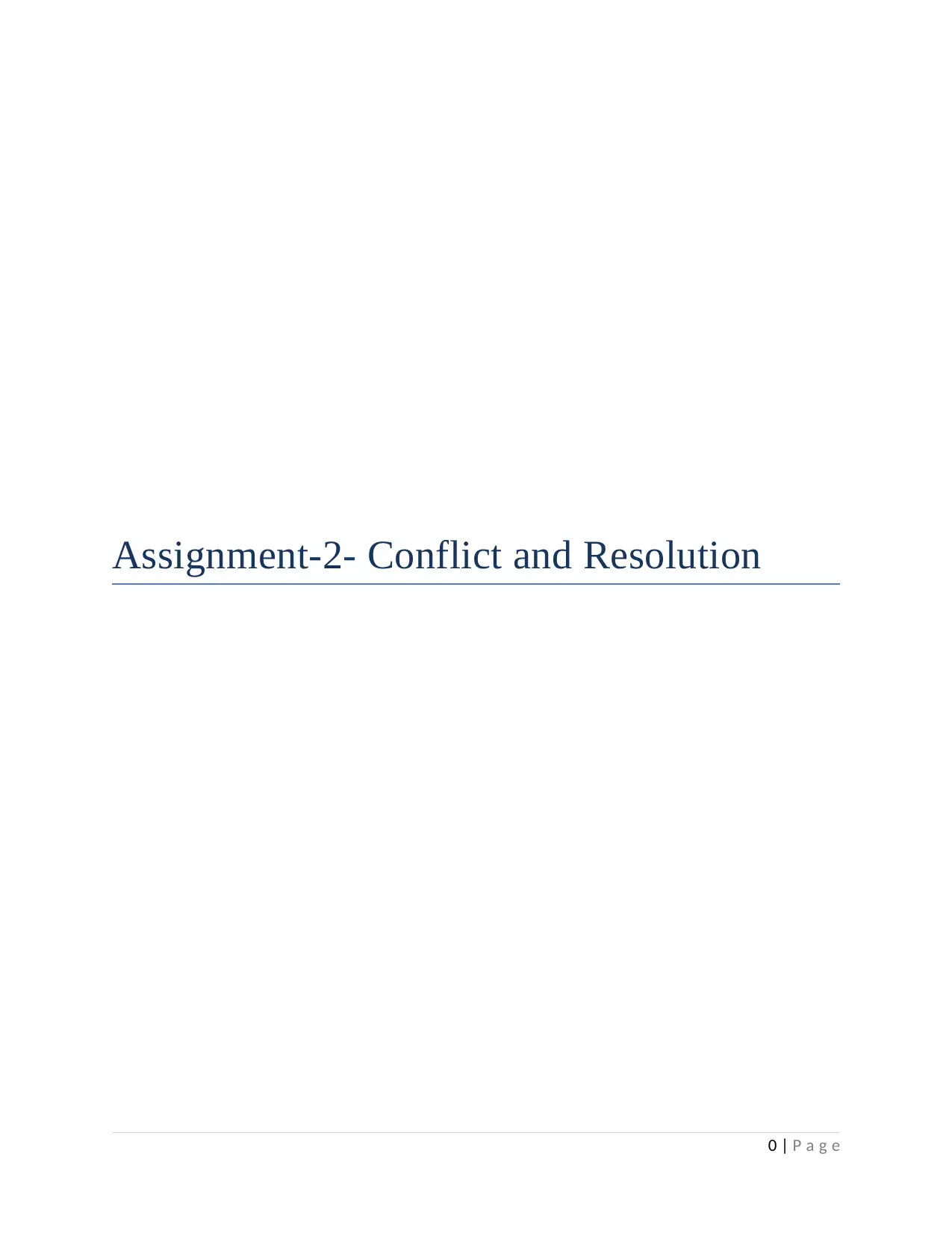
Assignment-2- Conflict and Resolution
0 | P a g e
0 | P a g e
Paraphrase This Document
Need a fresh take? Get an instant paraphrase of this document with our AI Paraphraser
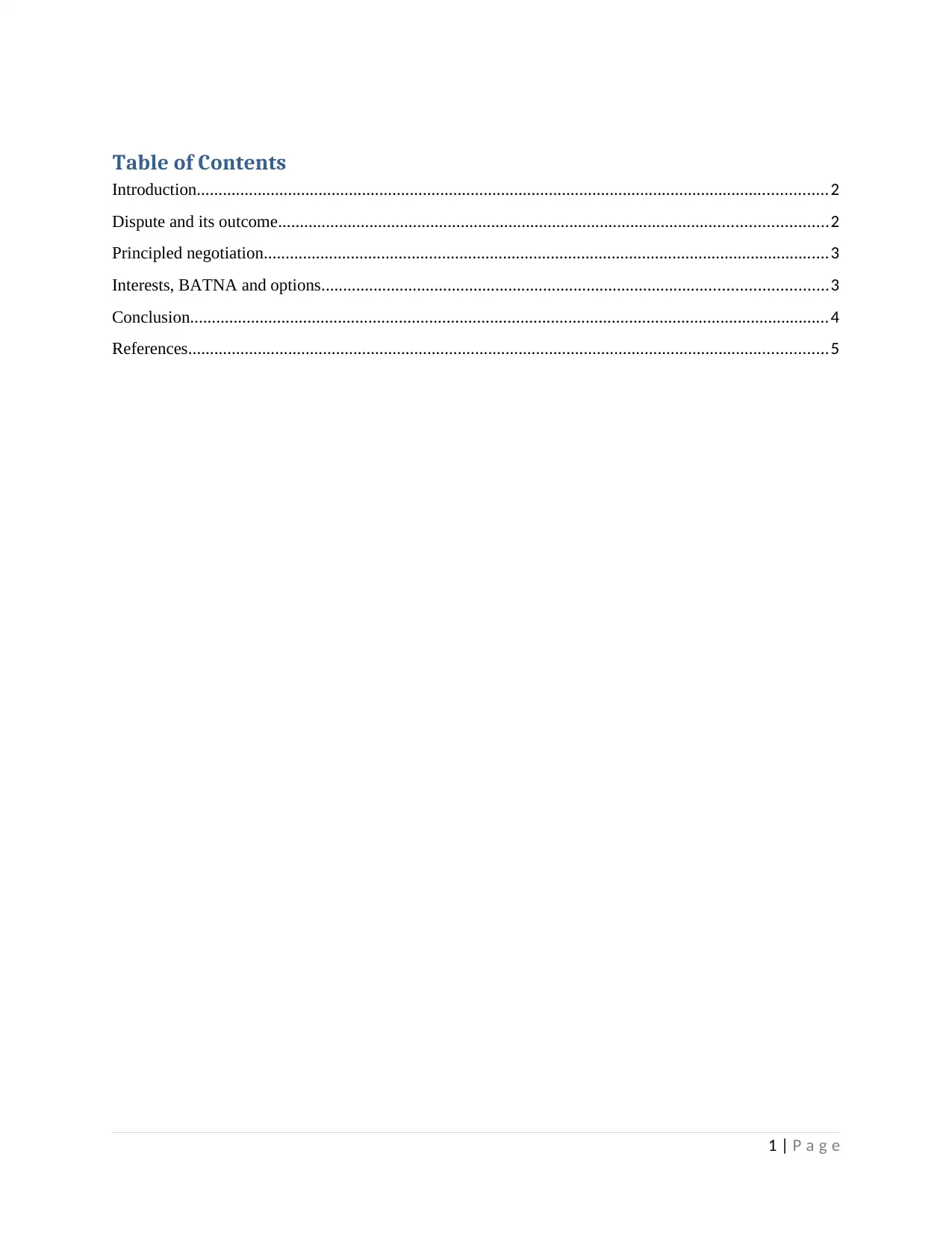
Table of Contents
Introduction.................................................................................................................................................2
Dispute and its outcome..............................................................................................................................2
Principled negotiation..................................................................................................................................3
Interests, BATNA and options....................................................................................................................3
Conclusion...................................................................................................................................................4
References...................................................................................................................................................5
1 | P a g e
Introduction.................................................................................................................................................2
Dispute and its outcome..............................................................................................................................2
Principled negotiation..................................................................................................................................3
Interests, BATNA and options....................................................................................................................3
Conclusion...................................................................................................................................................4
References...................................................................................................................................................5
1 | P a g e
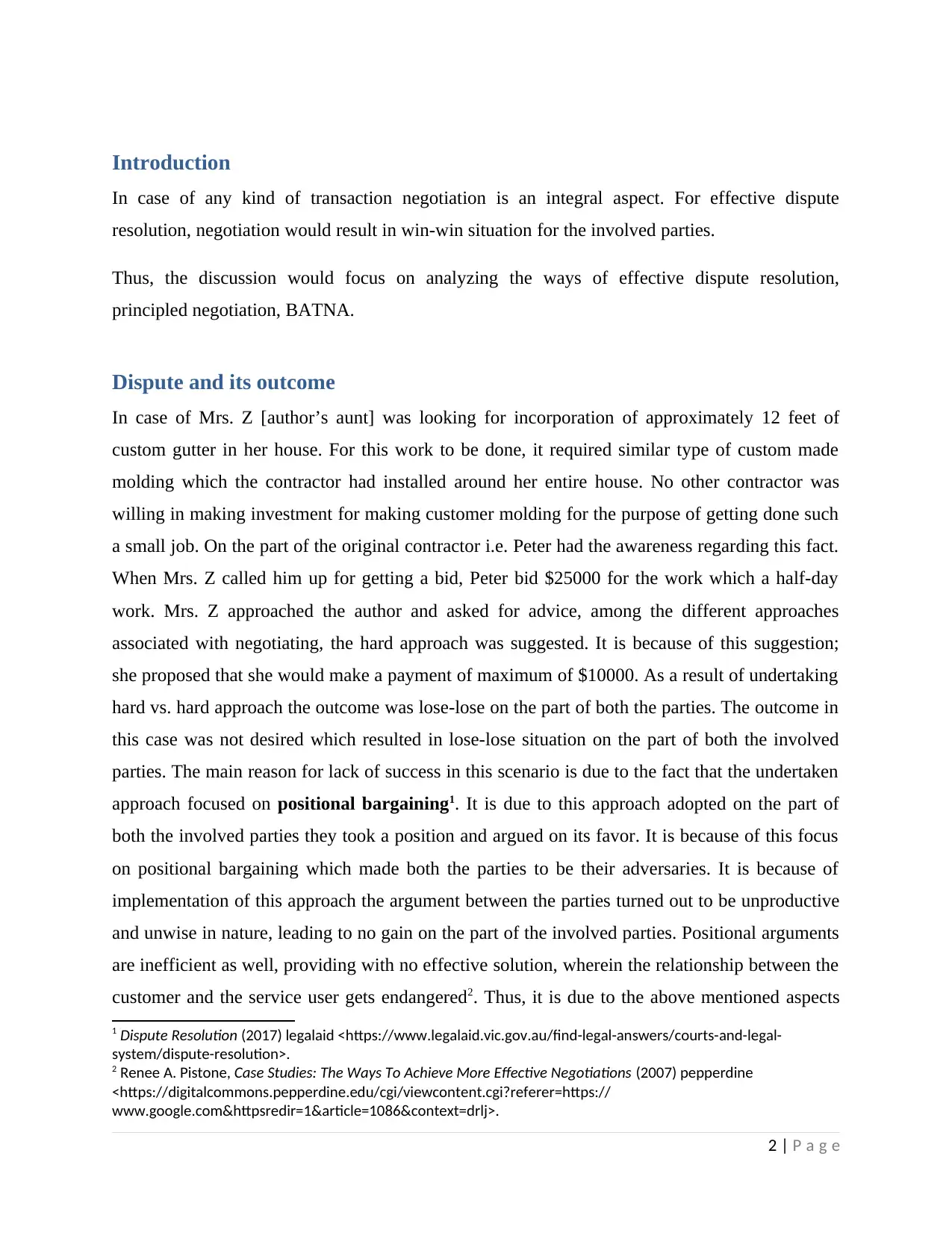
Introduction
In case of any kind of transaction negotiation is an integral aspect. For effective dispute
resolution, negotiation would result in win-win situation for the involved parties.
Thus, the discussion would focus on analyzing the ways of effective dispute resolution,
principled negotiation, BATNA.
Dispute and its outcome
In case of Mrs. Z [author’s aunt] was looking for incorporation of approximately 12 feet of
custom gutter in her house. For this work to be done, it required similar type of custom made
molding which the contractor had installed around her entire house. No other contractor was
willing in making investment for making customer molding for the purpose of getting done such
a small job. On the part of the original contractor i.e. Peter had the awareness regarding this fact.
When Mrs. Z called him up for getting a bid, Peter bid $25000 for the work which a half-day
work. Mrs. Z approached the author and asked for advice, among the different approaches
associated with negotiating, the hard approach was suggested. It is because of this suggestion;
she proposed that she would make a payment of maximum of $10000. As a result of undertaking
hard vs. hard approach the outcome was lose-lose on the part of both the parties. The outcome in
this case was not desired which resulted in lose-lose situation on the part of both the involved
parties. The main reason for lack of success in this scenario is due to the fact that the undertaken
approach focused on positional bargaining1. It is due to this approach adopted on the part of
both the involved parties they took a position and argued on its favor. It is because of this focus
on positional bargaining which made both the parties to be their adversaries. It is because of
implementation of this approach the argument between the parties turned out to be unproductive
and unwise in nature, leading to no gain on the part of the involved parties. Positional arguments
are inefficient as well, providing with no effective solution, wherein the relationship between the
customer and the service user gets endangered2. Thus, it is due to the above mentioned aspects
1 Dispute Resolution (2017) legalaid <https://www.legalaid.vic.gov.au/find-legal-answers/courts-and-legal-
system/dispute-resolution>.
2 Renee A. Pistone, Case Studies: The Ways To Achieve More Effective Negotiations (2007) pepperdine
<https://digitalcommons.pepperdine.edu/cgi/viewcontent.cgi?referer=https://
www.google.com&httpsredir=1&article=1086&context=drlj>.
2 | P a g e
In case of any kind of transaction negotiation is an integral aspect. For effective dispute
resolution, negotiation would result in win-win situation for the involved parties.
Thus, the discussion would focus on analyzing the ways of effective dispute resolution,
principled negotiation, BATNA.
Dispute and its outcome
In case of Mrs. Z [author’s aunt] was looking for incorporation of approximately 12 feet of
custom gutter in her house. For this work to be done, it required similar type of custom made
molding which the contractor had installed around her entire house. No other contractor was
willing in making investment for making customer molding for the purpose of getting done such
a small job. On the part of the original contractor i.e. Peter had the awareness regarding this fact.
When Mrs. Z called him up for getting a bid, Peter bid $25000 for the work which a half-day
work. Mrs. Z approached the author and asked for advice, among the different approaches
associated with negotiating, the hard approach was suggested. It is because of this suggestion;
she proposed that she would make a payment of maximum of $10000. As a result of undertaking
hard vs. hard approach the outcome was lose-lose on the part of both the parties. The outcome in
this case was not desired which resulted in lose-lose situation on the part of both the involved
parties. The main reason for lack of success in this scenario is due to the fact that the undertaken
approach focused on positional bargaining1. It is due to this approach adopted on the part of
both the involved parties they took a position and argued on its favor. It is because of this focus
on positional bargaining which made both the parties to be their adversaries. It is because of
implementation of this approach the argument between the parties turned out to be unproductive
and unwise in nature, leading to no gain on the part of the involved parties. Positional arguments
are inefficient as well, providing with no effective solution, wherein the relationship between the
customer and the service user gets endangered2. Thus, it is due to the above mentioned aspects
1 Dispute Resolution (2017) legalaid <https://www.legalaid.vic.gov.au/find-legal-answers/courts-and-legal-
system/dispute-resolution>.
2 Renee A. Pistone, Case Studies: The Ways To Achieve More Effective Negotiations (2007) pepperdine
<https://digitalcommons.pepperdine.edu/cgi/viewcontent.cgi?referer=https://
www.google.com&httpsredir=1&article=1086&context=drlj>.
2 | P a g e
⊘ This is a preview!⊘
Do you want full access?
Subscribe today to unlock all pages.

Trusted by 1+ million students worldwide
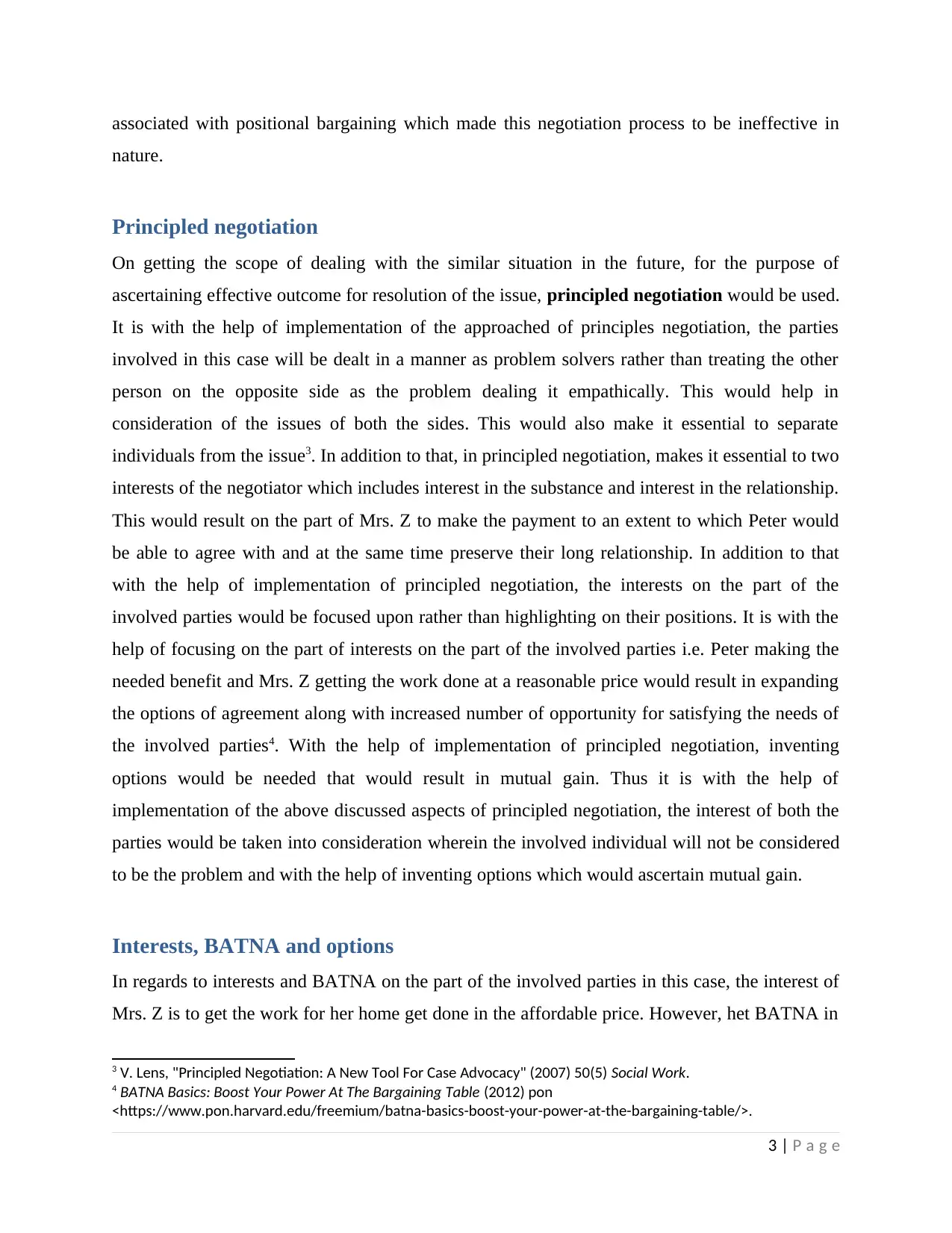
associated with positional bargaining which made this negotiation process to be ineffective in
nature.
Principled negotiation
On getting the scope of dealing with the similar situation in the future, for the purpose of
ascertaining effective outcome for resolution of the issue, principled negotiation would be used.
It is with the help of implementation of the approached of principles negotiation, the parties
involved in this case will be dealt in a manner as problem solvers rather than treating the other
person on the opposite side as the problem dealing it empathically. This would help in
consideration of the issues of both the sides. This would also make it essential to separate
individuals from the issue3. In addition to that, in principled negotiation, makes it essential to two
interests of the negotiator which includes interest in the substance and interest in the relationship.
This would result on the part of Mrs. Z to make the payment to an extent to which Peter would
be able to agree with and at the same time preserve their long relationship. In addition to that
with the help of implementation of principled negotiation, the interests on the part of the
involved parties would be focused upon rather than highlighting on their positions. It is with the
help of focusing on the part of interests on the part of the involved parties i.e. Peter making the
needed benefit and Mrs. Z getting the work done at a reasonable price would result in expanding
the options of agreement along with increased number of opportunity for satisfying the needs of
the involved parties4. With the help of implementation of principled negotiation, inventing
options would be needed that would result in mutual gain. Thus it is with the help of
implementation of the above discussed aspects of principled negotiation, the interest of both the
parties would be taken into consideration wherein the involved individual will not be considered
to be the problem and with the help of inventing options which would ascertain mutual gain.
Interests, BATNA and options
In regards to interests and BATNA on the part of the involved parties in this case, the interest of
Mrs. Z is to get the work for her home get done in the affordable price. However, het BATNA in
3 V. Lens, "Principled Negotiation: A New Tool For Case Advocacy" (2007) 50(5) Social Work.
4 BATNA Basics: Boost Your Power At The Bargaining Table (2012) pon
<https://www.pon.harvard.edu/freemium/batna-basics-boost-your-power-at-the-bargaining-table/>.
3 | P a g e
nature.
Principled negotiation
On getting the scope of dealing with the similar situation in the future, for the purpose of
ascertaining effective outcome for resolution of the issue, principled negotiation would be used.
It is with the help of implementation of the approached of principles negotiation, the parties
involved in this case will be dealt in a manner as problem solvers rather than treating the other
person on the opposite side as the problem dealing it empathically. This would help in
consideration of the issues of both the sides. This would also make it essential to separate
individuals from the issue3. In addition to that, in principled negotiation, makes it essential to two
interests of the negotiator which includes interest in the substance and interest in the relationship.
This would result on the part of Mrs. Z to make the payment to an extent to which Peter would
be able to agree with and at the same time preserve their long relationship. In addition to that
with the help of implementation of principled negotiation, the interests on the part of the
involved parties would be focused upon rather than highlighting on their positions. It is with the
help of focusing on the part of interests on the part of the involved parties i.e. Peter making the
needed benefit and Mrs. Z getting the work done at a reasonable price would result in expanding
the options of agreement along with increased number of opportunity for satisfying the needs of
the involved parties4. With the help of implementation of principled negotiation, inventing
options would be needed that would result in mutual gain. Thus it is with the help of
implementation of the above discussed aspects of principled negotiation, the interest of both the
parties would be taken into consideration wherein the involved individual will not be considered
to be the problem and with the help of inventing options which would ascertain mutual gain.
Interests, BATNA and options
In regards to interests and BATNA on the part of the involved parties in this case, the interest of
Mrs. Z is to get the work for her home get done in the affordable price. However, het BATNA in
3 V. Lens, "Principled Negotiation: A New Tool For Case Advocacy" (2007) 50(5) Social Work.
4 BATNA Basics: Boost Your Power At The Bargaining Table (2012) pon
<https://www.pon.harvard.edu/freemium/batna-basics-boost-your-power-at-the-bargaining-table/>.
3 | P a g e
Paraphrase This Document
Need a fresh take? Get an instant paraphrase of this document with our AI Paraphraser
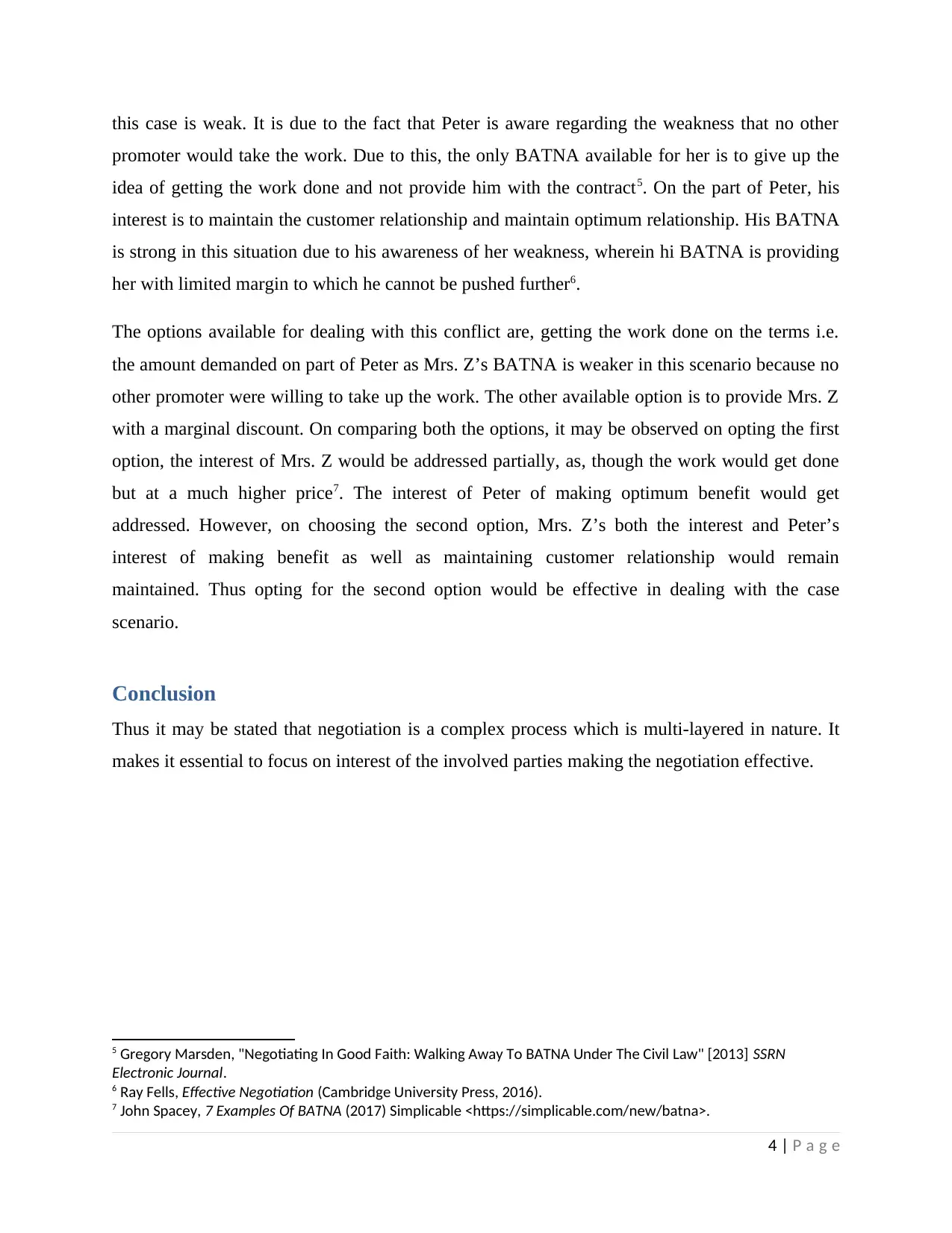
this case is weak. It is due to the fact that Peter is aware regarding the weakness that no other
promoter would take the work. Due to this, the only BATNA available for her is to give up the
idea of getting the work done and not provide him with the contract5. On the part of Peter, his
interest is to maintain the customer relationship and maintain optimum relationship. His BATNA
is strong in this situation due to his awareness of her weakness, wherein hi BATNA is providing
her with limited margin to which he cannot be pushed further6.
The options available for dealing with this conflict are, getting the work done on the terms i.e.
the amount demanded on part of Peter as Mrs. Z’s BATNA is weaker in this scenario because no
other promoter were willing to take up the work. The other available option is to provide Mrs. Z
with a marginal discount. On comparing both the options, it may be observed on opting the first
option, the interest of Mrs. Z would be addressed partially, as, though the work would get done
but at a much higher price7. The interest of Peter of making optimum benefit would get
addressed. However, on choosing the second option, Mrs. Z’s both the interest and Peter’s
interest of making benefit as well as maintaining customer relationship would remain
maintained. Thus opting for the second option would be effective in dealing with the case
scenario.
Conclusion
Thus it may be stated that negotiation is a complex process which is multi-layered in nature. It
makes it essential to focus on interest of the involved parties making the negotiation effective.
5 Gregory Marsden, "Negotiating In Good Faith: Walking Away To BATNA Under The Civil Law" [2013] SSRN
Electronic Journal.
6 Ray Fells, Effective Negotiation (Cambridge University Press, 2016).
7 John Spacey, 7 Examples Of BATNA (2017) Simplicable <https://simplicable.com/new/batna>.
4 | P a g e
promoter would take the work. Due to this, the only BATNA available for her is to give up the
idea of getting the work done and not provide him with the contract5. On the part of Peter, his
interest is to maintain the customer relationship and maintain optimum relationship. His BATNA
is strong in this situation due to his awareness of her weakness, wherein hi BATNA is providing
her with limited margin to which he cannot be pushed further6.
The options available for dealing with this conflict are, getting the work done on the terms i.e.
the amount demanded on part of Peter as Mrs. Z’s BATNA is weaker in this scenario because no
other promoter were willing to take up the work. The other available option is to provide Mrs. Z
with a marginal discount. On comparing both the options, it may be observed on opting the first
option, the interest of Mrs. Z would be addressed partially, as, though the work would get done
but at a much higher price7. The interest of Peter of making optimum benefit would get
addressed. However, on choosing the second option, Mrs. Z’s both the interest and Peter’s
interest of making benefit as well as maintaining customer relationship would remain
maintained. Thus opting for the second option would be effective in dealing with the case
scenario.
Conclusion
Thus it may be stated that negotiation is a complex process which is multi-layered in nature. It
makes it essential to focus on interest of the involved parties making the negotiation effective.
5 Gregory Marsden, "Negotiating In Good Faith: Walking Away To BATNA Under The Civil Law" [2013] SSRN
Electronic Journal.
6 Ray Fells, Effective Negotiation (Cambridge University Press, 2016).
7 John Spacey, 7 Examples Of BATNA (2017) Simplicable <https://simplicable.com/new/batna>.
4 | P a g e

References
BATNA Basics: Boost Your Power At The Bargaining Table (2012) pon
<https://www.pon.harvard.edu/freemium/batna-basics-boost-your-power-at-the-bargaining-
table/>
Dispute Resolution (2017) legalaid <https://www.legalaid.vic.gov.au/find-legal-answers/courts-
and-legal-system/dispute-resolution>
Fells, Ray, Effective Negotiation (Cambridge University Press, 2016)
Lens, V., "Principled Negotiation: A New Tool For Case Advocacy" (2007) 50(5) Social Work
Marsden, Gregory, "Negotiating In Good Faith: Walking Away To BATNA Under The Civil
Law" [2013] SSRN Electronic Journal
Pistone, Renee A., Case Studies: The Ways To Achieve More Effective Negotiations (2007)
pepperdine <https://digitalcommons.pepperdine.edu/cgi/viewcontent.cgi?referer=https://
www.google.com&httpsredir=1&article=1086&context=drlj>
Spacey, John, 7 Examples Of BATNA (2017) Simplicable <https://simplicable.com/new/batna>
5 | P a g e
BATNA Basics: Boost Your Power At The Bargaining Table (2012) pon
<https://www.pon.harvard.edu/freemium/batna-basics-boost-your-power-at-the-bargaining-
table/>
Dispute Resolution (2017) legalaid <https://www.legalaid.vic.gov.au/find-legal-answers/courts-
and-legal-system/dispute-resolution>
Fells, Ray, Effective Negotiation (Cambridge University Press, 2016)
Lens, V., "Principled Negotiation: A New Tool For Case Advocacy" (2007) 50(5) Social Work
Marsden, Gregory, "Negotiating In Good Faith: Walking Away To BATNA Under The Civil
Law" [2013] SSRN Electronic Journal
Pistone, Renee A., Case Studies: The Ways To Achieve More Effective Negotiations (2007)
pepperdine <https://digitalcommons.pepperdine.edu/cgi/viewcontent.cgi?referer=https://
www.google.com&httpsredir=1&article=1086&context=drlj>
Spacey, John, 7 Examples Of BATNA (2017) Simplicable <https://simplicable.com/new/batna>
5 | P a g e
⊘ This is a preview!⊘
Do you want full access?
Subscribe today to unlock all pages.

Trusted by 1+ million students worldwide
1 out of 6
Related Documents
Your All-in-One AI-Powered Toolkit for Academic Success.
+13062052269
info@desklib.com
Available 24*7 on WhatsApp / Email
![[object Object]](/_next/static/media/star-bottom.7253800d.svg)
Unlock your academic potential
Copyright © 2020–2025 A2Z Services. All Rights Reserved. Developed and managed by ZUCOL.





